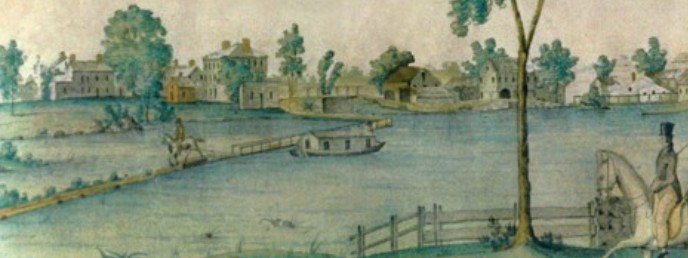


Middlesex Canal Association P.O. Box 333 Billerica, Massachusetts 01821
www.middlesexcanal.org
| Volume 52 No. 3 | April 2014 |
BREAKING NEWS
The Middlesex Canal Association has accepted the old Talbot cloth warehouse to be used as a future new Canal Museum. The warehouse is adjacent to the site where construction of the canal began. The deed was signed on February 5 and recorded on March 6, 2014. We will have more details and ways you can help in this exciting adventure in the next issue of Towpath Topics and perhaps, in the meantime, on the web site.
MCA ACTIVITIES
Please mark your calendars.
We are sponsoring two bicycle tours of the canal, south from Lowell on Saturday, April 12th, and north from Charlestown, likely on Sunday, October 5th.
The MCA-AMC Spring Walk will take place in Medford and Winchester on Sunday, April 27th.
Our Spring Meeting will be held on Sunday, May 4th, 2014, in the museum, beginning at 1 PM. Refreshments will be served.
See the Calendar, following, for more information on our activities. Also included are meetings and tours, sponsored by other canal and related organizations, in which you may want to participate.
Please also check our web site now and then, at the URL noted above in the nameplate, which also lists canal-related events and topics of potential interest, sometimes including those that don’t make it into Towpath Topics.
TABLE OF CONTENTS
President’s Message (J.J. Breen)
Calendar of Events
For Future Planning
Transfer of Legacies (M. Henderson)
Black Brook Aqueduct (Gerber)
Measuring Speed on the Canal (Gerber)
1816 Tow Boat (Gerber)
Quirky Museums (Boston Globe)
Canal Toll House, Chelmsford (Gerber)
Miscellany
Photo of Shawsheen Aqueduct in October 2013 (Kathy Norton)
PRESIDENT'S MESSAGE
by J. Jeremiah Breen, President; jj@middlesexcanal.org
The Rutherford Avenue/Sullivan Square Design Project by the City of Boston is an opportunity to establish the Middlesex Canal Heritage Park described in the the 1977 law that authorized the Middlesex Canal Commission. At the Rutherford Avenue end, Douglas Adams and Wilbar Hoxie, 2nd and 3rd presidents of the Association, found in a sewer excavation a remnant of the millpond dam as reported in Towpath Topics, April 1973. Neither Prof. Adams nor Col. Hoxie was able to establish a permanent marker of the significance of the location.
At the Sullivan Square end of the project, the design includes an actual square, or park. This should, of course, commemorate the life of James Sullivan, first president of the Middlesex Canal Company (and of the Massachusetts Historical Society, etc.). The biography of him in Towpath Topics, Jan 2011, by the stalwart treasurer of the Association, Howard Winkler, cites The Life of James Sullivan, 850 pages by Sullivan’s grandson, Thomas Amory. The designer of Sullivan Square would probably start and stop with what is in comparison a biographical note like our treasurer’s rather than download and read Amory. But Amory has the memorable details of Sullivan’s life. For example:
In February, 1783, George, the youngest son, was born; and, a year later, Nancy, the youngest child, who lived but fifteen months. On the twenty-sixth day of January, 1786, Mrs. Sullivan, who in the morning had presided at the breakfast-table, surrounded by her bright and happy group of children, was taken suddenly ill, and died at eight o’clock the same evening. To a man of keen and ardent feelings, who fondly loved the partner of all his joys and sorrows since early manhood, her loss, when they were both but at the middle stage of life, was a heavy shock. In a letter written to his friend, Rufus King, from beside her coffin, he says:
“On Thursday morning last I felt myself as happy as I wished. I breakfasted with a lady whom you know I adored. She was cheerful and gay, but before eight o’clock in the evening she was a breathless corpse. For the space of nine hours’ illness, the skill of physicians was exhausted in vain attempts to save a life dear to many, but infinitely so to me and her seven children. She now lies by me while I write; but her lips are forever sealed, nor do her frozen eyelids permit those charms which so constantly have beamed pleasure on my soul. I cannot, nor ought I, to write to communicate to you the feelings of my heart. 0, my friend! you will pity me. A life of gloominess and anxiety awaits, and, had I not now the double charge of these orphans, my earnest prayer would be to go down with her to the silent tomb.”
Again, some three months later, while still under the poignancy of recent bereavement, he writes to the same friend:
“Your letter is kindly addressed to a heart suffering in all the severity of grief. I thank you for your care of my health, in the expressing of which you so intimately enter into my feelings. My dear children demand much from me, and deserve everything. I am obliged to appear quite otherwise than I am, to keep up their spirits; and I give you the pleasure of knowing that my health is better than it has been for a long time past. My dear King, I have now nothing left for me but a fearful anxiety, and a dull, heavy, downward road of life. She for whom alone I lived, she who wished to live for me, is now no more. Religion points her out to me in the company of angels; but that form, in which she blessed me with every domestic happiness for eighteen years, is now mouldering in the tomb. O, could I, were any such thing possible, see her happy shade, I would lay me down night after night in the gloomy church-yard to enjoy the sight! I see I am wild. There is a luxury in grief some men have not the capacity to enjoy. May God long preserve you, my dear friend, from that kind of sorrow which, to a man of your generous sensibility, would be like the arrows of death indeed.”
“I can write to my brother with composure; but I know not how it is, that, when I address you, the tears are spontaneous, and flow with pleasure. I rejoice that you are joined to a lady in the way which makes friendship certain. I am rich in your happiness, because I hear that it is founded on the connection of virtue and amiability. Enjoy each moment; they look big with pleasure as they advance, but, when they are passed, they are annihilated. How many moments have passed unheeded which I might have filled with love and joy! But they will no more return. Nor can I now grasp one sprig of happiness on this side of the grave. My dear King, pardon this effusion. It may bear the candid eye of a friend like you, but would blush at other eyes.”
“I cannot refrain from telling you that the more you rise in the world, the more you will augment my pleasure; for I do assure you, with the greatest sincerity, that the prosperity of no man on earth, my brother not excepted, ever gave me more satisfaction than your own. Will you oblige me by begging your lady, in my name, to accept the tender of friendship from a man who once enjoyed a felicity like yours, and whose sole object was to make an amiable woman happy as you will make her?”
Thomas C. Amory, “Life of James Sullivan”, 1859, Vol. 1, pp. 178-180, http://www.archive.org/details/lifejamessull01amorrich, pp. 198-200.
Including the State Middlesex Canal Heritage Park established by the 1977 law as part of the Rutherford Avenue/Sullivan Square Design Project is an opportunity to commemorate James Sullivan and mark the remnant of the dam discovered by Adams and Hoxie.
Notes:
1. The Rutherford Avenue – Sullivan Square Design Project: http://www.cityofboston.gov/transportation/rutherford/
2. Not in Amory is a memorable letter by Sullivan’s mother in the July 25, 1743 Boston Evening Post, http://tinyurl.com/letter-of-contrition
J. Jeremiah Breen
CALENDAR OF EVENTS
Middlesex Canal Association (MCA) and Related Organizations
The Middlesex Canal Museum and Visitors’ Center is open every Saturday and Sunday, noon-4, except holidays.
First Wednesday - MCA Board of Directors' Meetings - The Board meets at the Museum, from 3:30 to 5:30pm, the first Wednesday of every month, except July and August. Members are always welcome to attend.
Directions to the Museum/Visitors Center: Telephone: 978-670-2740.
By Car:
From Rte. 128/95, take Route 3 toward Nashua, to Exit 28 "Treble Cove Road, North Billerica, Carlisle". At the end of the ramp, turn left onto Treble Cove Road toward North Billerica. At about ¾ mile, bear left at a fork. After another ¾ mile, at a traffic light, cross straight over Route 3A. Go about ¼ mile to a 3-way fork; take the middle road, Talbot Street, which will put St. Andrew's Church on your left. Go about ¼ mile and bear right onto Old Elm Street. Go about ¼ mile to the falls, where Old Elm becomes Faulkner Street; the Museum is on your left and you can park across the street on your right, just beyond the falls.
From I-495, take exit 37, N. Billerica, south to the road's end at a "T" intersection, turn right, then bear right at the Y, go 700' and turn left into the parking lot. The Museum is across the street.
By Train: The Lowell Commuter Line runs between Boston's North Station and Lowell's Gallagher Terminal. Get off at the North Billerica station, which is one stop south of Lowell. From the station side of the tracks, the Museum is a 3-minute walk down Station and Faulkner Streets on the right side.
Sun, April 6, 2014: Blackstone Canal Conservancy walk through hike in the Blackstone River & Canal Heritage State Park. Hike from Plummers Landing, Northbridge to Riverbend Farm, Uxbridge. About 3 miles. Meet at 1 PM at Riverbend Farm, 287 Oak Street, Uxbridge and car shuttle to Plummers Landing. Hike will be at a leisurely pace and will point out canal landmarks along the way. Wear good footwear and dress for the weather. For information see www.blackstonecc.org/calendar.htm.
Augusta (GA) Canal, Guided Bicycle Rides -”Pedal through the Past”. Various weekends. Bring your bike and enjoy a ride along the canal towpath with an experienced Augusta Canal tour guide. You’ll learn a bit about the history, engineering and natural surroundings that make the Augusta Canal a National Heritage Area. For information see http://www.augustacanal.com/Default.aspx?PageId=9.
Sat, April 12, 2014: Middlesex Canal Association’s Spring bicycle tour. Meet 9:30AM at North Station (commuter rail) and take our bicycles on the 10AM train to Lowell. Riders meeting the group at Lowell meet at the train station at 10:40. This year an early group will take the 8:00AM train from North Station to allow more time in Lowell and breakfast at the historic Owl Diner (http://www.owldiner.com, aka the Four Sisters). Route visits the Pawtucket and other Lowell canals, the river walk, Francis Gate, and then Middlesex Canal remnants in Chelmsford. Lunch at Route 3A mini-mall in Billerica. Quick visit to Canal Museum, then on to Boston. A long day of exploration (35 miles end-to-end) but sunset is late. (Riders can board northbound trains at other stations or catch southbound trains at 1:07 or 3:14PM to return to Boston early. Complete Lowell line schedules can be downloaded at http://www.mbcr.net) Participants are responsible for one-way train fare [$8.75 from Boston to Lowell]. For changes or updates, see www.middlesexcanal.org. Leaders Bill Kuttner (617-241-9383) & Dick Bauer (857-540-6293).
Walks along the Morris and the Delaware & Raritan Canals in New Jersey. Various weekends. For information see http://www.canalsocietynj.org/upcoming_canal_walks_in_2014.pdf.
Apr 20, 2014: The Middlesex Canal Museum will be closed on Easter Sunday.
Apr 25–27, 2014: Joint Pennsylvania Canal Society and Canal Society of Ohio Spring tour of the Ohio and Erie Canal. The American Canal Society directors’ meeting will be held in conjunction with this trip. The tour will be based in Akron, OH. For more information see www.pacanalsociety.org, www.canalsocietyohio.org and/or www.americancanals.org.
Apr 25–27, 2014: Chesapeake & Ohio Canal Association - The 60th anniversary Justice William O. Douglas thru-hike and dinner have been canceled. Other events will be substituted. See www.candocanal.org/news/2014-thru-hike.html for more information.
April 25–27, 2014: Virginia Canal and Navigations Society’ Annual Conference at Glen Maury Park, Buena Vista, VA. For information about this and the James River Batteau Festival in June, see www.vacanals.org.
Sunday, April 27, 2014: Joint Middlesex Canal Association - Appalachian Mountain Club Spring Walk. This walk is jointly listed as a Local Walk of the Boston Chapter of the Appalachian Mountain Club (AMC). “Show and Go”; meet at the Sandy Beach parking lot off the Mystic Valley Parkway by the Upper Mystic Lakes in Winchester. The walk will follow the route of the Middlesex Canal through parts of Medford and Winchester. Sites along the way include the aqueduct and mooring basin, those segments of the canal bed and berm visible off the parkway, and the stone wall of the Governor Brooks estate, in Medford. For additional information, contact Robert Winters (617-661-9230) or Roger Hagopian (781-861-7868).
Sunday, Apr. 27, 2014: Blackstone River Watershed Association Earth Day clean up. Come help remove trash from the river. 1-3PM, Meet at Riverbend Farm, 287 Oak Street, Uxbridge, MA.
May 2-4, 2014: Canal Society of New York State Spring 2014 Field Trip will explore the Chesapeake and Ohio Canal; Headquarters will be in Hagerstown MD. Check www.newyorkcanals.org/explore_events.htm for additional information.
Saturday, May 3, 2014: Society for Industrial Archeology, Southern & Northern New England Chapters. Joint tour of the Middlesex Canal, North Billerica to Woburn, MA; held in conjunction with the Middlesex Canal Association. Tour starts @ 9:30AM at the Middlesex Canal Museum, 71 Faulkner St, North Billerica, Mass. (See directions to the museum, above.) Cost: $10 per person, includes bus transportation along the canal route to Woburn. See http://nec-sia.org for more information.
Sunday, May 4th, 2014: Middlesex Canal Association Spring Meeting will be held in the museum, beginning at 1PM. Our speaker will be Ken Williamson; his topic “Inclined to Succeed: The South Hadley Canal.” Mr. Williamson taught organic chemistry at Mount Holyoke College for 38 years and, for may years, has researched and written about the South Hadley Canal. With its Inclined Plane, the SHC was one of the most technologically ambitious enterprises attempted in the young United States; Loammi Baldwin visited the site in the Spring of 1994, while it was still under construction. Refreshments will be served.
May 15-18, 2014: Society for Industrial Archeology Annual Conference will be held in Portland Maine. Tours of the Bath Iron Works and the Maine Maritime Museum will be included. See www.sia-web.org for more information.
May 17, June 14 and July 12, 2014: Blackstone Canal Conservancy work days, 9AM, Plummers Landing west parking area, Church St. Northbridge, MA.
July 24 to Aug 3, 2014:. Cape Cod Canal Centennial Celebration. A weeklong celebration will be filled with maritime-themed events, from historical exhibits and tall ships on display, to a tugboat parade and children’s activities along the canal. There will be an opening gala and a grand ball as well as a tour of the historic Charles W. Morgan, the last surviving wooden whaling ship. See www.capecodtoday.com/article/2013/01/19/16597-cape-cod-canal-centennial-coming-next-year for a synopsis, capecodcanalcentennial.com/events/ for a listing of events, and/or search for “Cape Cod Canal Centennial” for further information.
2014 - World Canals Conference, Navigli Lombardi, Milan, Italy
FOR FUTURE PLANNING
Tentative Dates for the Fall MCA activities are as follows:
Sunday, October 5, 2014 - Bike Tour, north-bound, starting at 9:00am
Sunday, October 19, 2014 - MCA-AMC Fall Walk, TBD
Sunday, October 26, 2014 - Fall Meeting
These dates may change slightly based upon the personal schedules of trip leaders and speakers. Please check website a few weeks before for any changes.
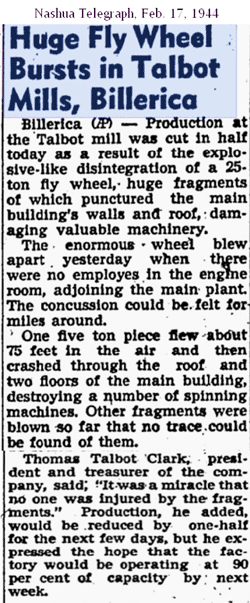 TRANSFER OF LEGACIES
TRANSFER OF LEGACIES
by Marlies Henderson
Alec Ingraham, from Billerica, treated me to a striking story about the Cloth Warehouse; a storage building across the street from the Talbot Mills. The key to this warehouse has recently changed hands from Pace Industries to the Middlesex Canal Association, and the idea to have a new location for our canal museum is finally blossoming.
Alec told me that the Talbot family used to live nearby, on Mount Pleasant Street. Their estate no longer exists, except for two monumental pillars that still guard what used to be a parcel of land reaching from Doris Avenue to the railroad; not much is left there to preserve the memory of former Massachusetts Governor Thomas Talbot!
On the same street and still standing is a yellow rooming house, formerly the residence for generations of the Clark lineage. Alec’s grandfather was the trusty caretaker of this manor. He lived in a similar but more humble house on the same property. Consequently, Alec’s mother, Margaret, often babysat Frederick Clark’s grandchildren and some of these kept in touch with her long after they had moved on with their lives. Even after his retirement, Hayden Clark would from time to time return to his roots in Billerica, either to visit with Ruth Potter, his secretary from the days when he managed the Talbot Mills, or he’d stop by to visit Margaret. Alec hung around eagerly to pick up fragments of their conversation as they reminisced over photo albums.
Alec distinctly recalls a yellowed picture taken from Rogers Street towards the Mills, featuring the warehouse, which prompted Hayden to dig up an old 1944 memory: Serving the US forces in the Pacific he was stunned by a newspaper article about a blast which took place at the Talbot Mills! Which publication did he read?
The February 16, 1944 Nashua Newspaper reported the incident of a 25 foot diameter flywheel, weighing 42 tons, disintegrating explosively, be it that in the rush to the printer, it reported a “25 ton” flywheel. The Lowell Sun also printed the incident on its front page: “Scores escape as huge steel mass hurtles through power plant roof and crashes down five floors”. The headline was eerily surrounded by news from a war raging on front lines around the globe.
Miraculously no casualties occurred, but it stung Hayden that he had to learn about this mishap from the public media. He may have heard more later from his relatives, because he embellished the newspaper reports with inside information, revealing that pieces from the disintegrated flywheel were shot 70 to 100 feet up through the roof, and one of the pieces, raining down, crashed through the roof of the cloth warehouse across the street; others splashed into the water of the mill pond.
The photo below gives an idea of the size of the flywheel. Alec remembers how his mother was fascinated by the wheel house. She’d tell that a Mr. Roome polished the wheel daily and used to scold her to back off.
After a slight pause, Alec added that the Clark family, being the way they were and having access to a broad selection of craftsmen at their own mills, would have quickly repaired the damage. Remarkable, however, is the fact that the warehouse is missing part of its second floor in the same area where the roof was damaged, and the two sides of its roof are covered with different materials. The roof panel facing North is still covered with slate, but the damaged Southern panel is covered with asphalt shingles. There is also a rumor that the building was also struck by lightning, which charred a roof support beam within the building, causing it to collapse, and so some of the roof repairs may also date to that event.
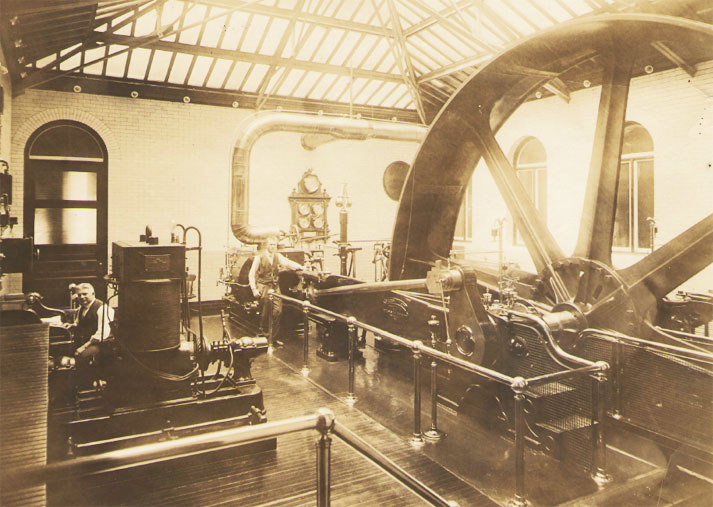
Likely there are people within the local community who know still more of the history of the warehouse. If so, I invite them to contact me so that I can fill in the blanks that currently exist.
When the Middlesex Canal Mill Pond Park was first discussed in 1997, Alec told Hayden’s story, which marked the moment the Talbot Cloth Warehouse was first mentioned as a possible site for a museum. Current developments bring the plans one step closer to fruition!
BLACK BROOK AQUEDUCT
by Bill Gerber
 Most MCA members are familiar with the Shawsheen Aqueduct, the abutments and remaining pier of (three of) which are visible from Route 129 in Billerica, near the Wilmington line. Similarly, many have participated in canal walks that visited the site of the Maple Meadow Brook Aqueduct in Wilmington. And Tom Raphael recently wrote about the Symmes River Aqueduct in Winchester (see TT 9/2011). But there were eight aqueducts along the Middlesex Canal. What about all of the others? Information about four of the remaining five will have to wait for future research. This article will describe what we know about the Black Brook Aqueduct.
Most MCA members are familiar with the Shawsheen Aqueduct, the abutments and remaining pier of (three of) which are visible from Route 129 in Billerica, near the Wilmington line. Similarly, many have participated in canal walks that visited the site of the Maple Meadow Brook Aqueduct in Wilmington. And Tom Raphael recently wrote about the Symmes River Aqueduct in Winchester (see TT 9/2011). But there were eight aqueducts along the Middlesex Canal. What about all of the others? Information about four of the remaining five will have to wait for future research. This article will describe what we know about the Black Brook Aqueduct.
Shown in the clip to the right, Black Brook Aqueduct was located in Middlesex Village, Chelmsford (though now part of Lowell), south of the Merrimack Flight of Locks and immediately north of the “Long Block” glass workers’ houses (which, by the way, still stands near the NW corner of Princeton Blvd and Baldwin St.), note “Aqueduct” and “Long Block” just below the brook near the bottom of the clip.
Shown below are two sketches of the Black Brook Aqueduct, one as it appeared looking east, and the second - looking west. Both sketches are taken from Leon Cutler’s collection of glass slides, which date to the late 1920s and early ‘30s.
The provenance of the sketches is not known, but they appear to have been drawn by a young person or persons. Because they show essentially the same features, depicted in very similar fashion, they tend to corroborate each other, and for that reason they are well worth examining.
From the sketches, we can make a number of observations. Black Brook Aqueduct was quite long, built upon two abutments and four piers. The piers bear a similarity to those of the Medford Aqueduct after it was rebuilt in the late 1820s, so the sketches of Black Brook are probably of the aqueduct after it too was rebuilt.
In his PhD thesis, Christopher Roberts described the aqueduct as follows:
“Passing under the main street at Middlesex Village, the canal crossed Black Brook in a wooden aqueduct near the site occupied, when the canal was completed, by a glass factory. The aqueduct, with abutments 110 feet apart, was supported by ten wooden piers on stone foundations. Its trough, about ten feet above the stream below, was made of timber and plank, with the timber framed together by tenons and mortises and strengthened by braces. Had the construction been with knees and bolts, after the fashion of shipbuilding, it would doubtless have been more durable.”
Elsewhere, in a footnote, Roberts noted:
“The aqueduct covered eleven spaces of ten feet each, with ten framed timber pieces serving as piers, exclusive of two stone abutments. The piers rested on stone foundations raised about one foot above the ground.”
That the sketches are not of the original configuration is reinforced by the fact that the construction shown is not like that described above, nor of the early Medford Aqueduct, as it appeared in the drawing of the towboat Merrimack crossing that structure in August 1818. Descriptions suggest that the original Black Brook Aqueduct was of similar construction.
In his manuscript, Lewis Lawrence describes Black Brook Aqueduct much as Roberts did, but provides more of the history of it, as follows:
“In 1817, the aqueduct over Black Brook was supported by two stone abutments 110 feet apart, and 10 wooden piers. The water in it was 16 feet above the stream below. It was probably rebuilt in 1818 or 1819, for in the latter year it was “new” and 120 feet 8 inches long. In January 1827, it was described as a “Wooden Acquaduct” about 75 feet long. A sketch made in 1830, shows two stone abutments 120 feet apart and about 13 feet high, the piers not being indicated. The aqueduct was rebuilt in 1846. As shown by an old picture it then had two stone abutments, and four stone piers. The trunk was about 12 feet wide and 75 feet long with the towing path on the westerly side.”
The New York Canal Commissioners, who visited the Middlesex Canal in 1816, prior to initiating construction on the Erie Canal, described the early aqueduct in almost identical terms:
“In Chelmsford, within 60 rods of the Merrimack, is an aqueduct, of which the abutments are 110 feet apart, and there are ten wooden piers to support it. The water in the aqueduct is 16 feet higher than the stream below.”
At another point in their report the Commissioners observed:
“These aqueducts all afford convenient waste-weirs. When the water is not drawn off from the canal at the commencement of winter, the expansion of its freezing, spreads and injures the timbers of the aqueducts; wherefore, it is the practice, just before the winter sets in, to draw off about one third of the water.”

Black Brook Aqueduct, looking East
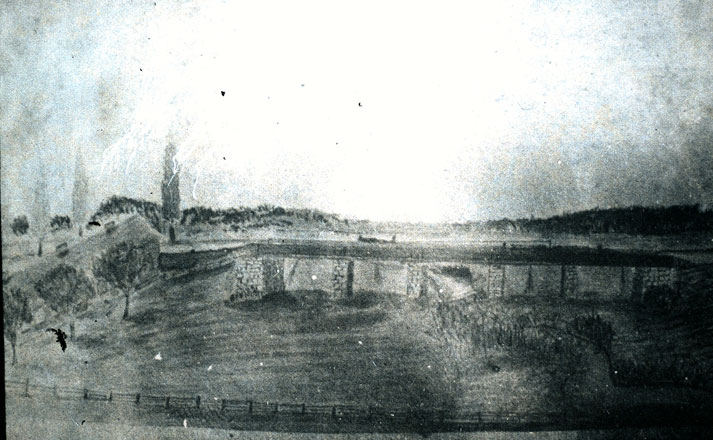
Black Brook Aqueduct, looking West
Lawrence’s description suggests that the sketches may be of the aqueduct as it was after 1846. (But one can only wonder how the canal company would have obtained the money to rebuild the aqueduct that late in the life of the canal. By then, much of the canal’s business had been drawn off by the railroads, which reached Lowell in 1835, Nashua in 1838, and Concord NH in 1842.)
There is a canal boat shown crossing the aqueduct in each of the two sketches. Both appear to be headed southbound, and both exhibit a towline attached to a towing mast forward of the center of the boat. (And note the consistency of the load carried by the boat in the east-looking view.) The towpath was along the west side of the aqueduct; that only the body portion of the tow animal shows suggests that there was an outer wall along its length.
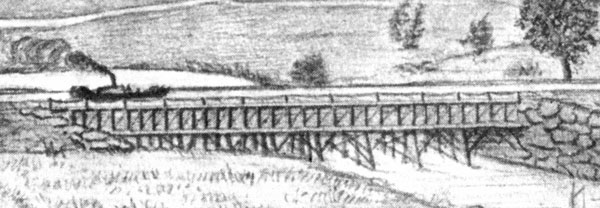
Steam Towboat "Merrimack" crossing the Canal aqueduct at Medford
MEASURING SPEED ON THE CANAL
by Bill Gerber
In early January, Chris Hart, Historian for Roscoe Village (a restored Ohio & Erie Canal town near Coshocton, Ohio), asked Terry Woods, an Ohio representative to the American Canal Society (ACS), for “access to some forms used by toll collectors to figure and collect tolls”; and he posed the question: “if the speed limit on the canal was say 4 miles an hour, how did they clock that....obviously they didn’t have radar”. Terry emailed Chris’s queries on to the greater canal aficionado community.
I was able to assist Terry and Chris with information from M’sex Canal records: to the article about Middlesex Canal Passports; and to alert him to the impending article about cargos and shipping documents from the M’sex Canal Company archives, as follows:
The Middlesex Canal used several different forms to account for the cargos that were carried. The ‘official’ form was the “Passport”. Bob Keintz, former PCS President, sent me one which I wrote up for Towpath Topics, the newsletter of the M’sex Canal Assoc. The writeup is available to you [in TT-3/2012, see “Middlesex Canal Passports”].
There are over 200 of the various documents in the archives of the M’sex Canal Company. I’ve built a database of the information content of them … an article, and a copy of the data base (too large to put in the newsletter), [is now available to you in TT-1/2014, see “Shipping Documents”].
As for information about speed on the canal, and the enforcement thereof, I provided the following:
Regarding speed limits on the canal, I’m not aware of any method that was used to measure speed, nor have I seen evidence that anyone tried to measure it on the M’sex or anyone else’s canal. However, there is a visual [and audible] phenomenon that occurs at about 3-1/2 to 4 mph that could be used, sort of as a ‘not-faster-than’ gauge. Below this speed, bow-wake tends to rise and fall gently, but above this speed the wake begins to curl. Canal maintainers claim that the curl tends to scour the banks, for which they take a very dim view.
On the M’sex, the limits were 1-1/2 mph for rafts of logs and ‘bands’ of rafts (a train of linked rafts); 2-1/2 mph for freight boats; and 3-1/2 mph for packets. My best guess is that 1-1/2 mph was the walking pace of oxen, the critters usually used to tow rafts; that 2-1/2 mph was the walking pace of a horse; and that 3-1/2 mph was the pace of a horse or horses (evidence suggests that two horses were used to tow the packets) at a fast walk or slow trot (evidence is that packet horses were swapped out midway down the canal, after about a 14 mile run). However, there is strong evidence that the packets exceeded the speed limit by a considerable margin. See “Scofflaws ...” [at TT-4/2010].
Dave Barber, current President of the ACS, added the following to the discussion:
I suspect that the 4 miles per hour was just a nominal speed. There could have been a use of telegraph timing on some canals such as the Delaware & Hudson. But, I expect not.
Anyone who has canal boated in England knows that one is told not to create a “breaking wake”. This occurs at about 4 miles per hour. Holding the tiller at the back of the boat in the open air, it is very obvious when this happens. It is also audible to anyone else either on the boat or on the towpath. But the speed at which this occurs is dependent on the shape of the hull in the water, the depth of the water, and the width of the canal. In narrower, shallower canals, you have to go slower. Breaking wakes occur suddenly when a boat passes through a bridge “hole” where the canal is significantly narrower. But, bridge holes are usually hardened with stone to fight this scouring.
Dave’s point about the hardening of ‘bridge holes’ (i.e., the narrowed, single lane width of the canal under a bridge on early canals) gives added understanding to the statement from John Langdon Sullivan’s Annual “Report to the Proprietors of the Middlesex Canal, at their Meeting, January 25, 1809”, that
“Other improvements have been made. The walls of the towing-paths under the bridges have been every where capt, to prevent the stones from being thrown off by the boats.”
Although they’re probably stated in earlier issues of TT, this might be a good time to repeat a few words about the regulations for boats and rafts traveling on the M’sex Canal.
The rate of moving in the Canal.
Passage Boats are to be drawn at the rate of three miles an hour.
Luggage Boats are to be drawn at the rate of two and an half miles an hour.
Rafts are to be drawn at the rate of one and an half mile an hour.Passing each other.
A Passage Boat [aka a Packet], going the same way with a Luggage Boat or Raft, shall have a right to pass by them.
A Luggage Boat [aka a boat carrying freight], going the same way with a Raft, shall have a right to pass it.
N.B. This rule is to apply alike to all Boats and Rafts, as well to those of the Proprietors of the Canal.Manner of passing going the same way.
The Boat or Raft to be passed, immediately on being come up with, shall slack its towing-line, and make room between itself and the towing-path, so that the Boat passing and the cattle or horses drawing the same, shall go over the towing-line of the Boat or Raft to be passed.How Boats meeting are to pass each other.
When a Boat going from the Concord River to the Merrimack, shall meet a Boat coming from the Merrimack, it shall be obliged to slack its towing-line for the other to pass in manner aforesaid.
When Boats meet in the Canal between Concord River and Charles River, the Boat coming from. the Concord, shall slack its towing-line in manner aforesaid, for the Boat going up towards the Concord to pass it.
In all cases, Rafts meeting Boats shall slack their towing-lines for the Boats to pass them.
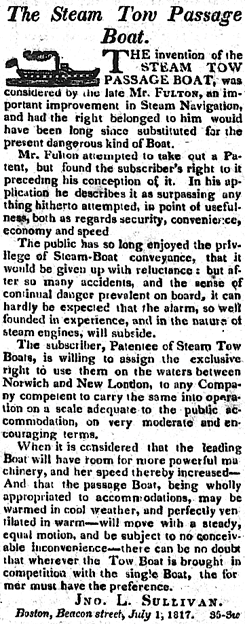 THE 1816 TOW BOAT
THE 1816 TOW BOAT
by Bill Gerber
In the February 2010 issue of Towpath Topics, I described the development and use of J. L. Sullivan’s steam tow boats. In that article I described five generations of development, the variations within several of them, and identified about two dozen patents that were generated as part of related actions. But one generation, the 1816 boat, largely eluded my research.
Since that time, historical bits and pieces have emerged to reveal a little more of the history of that boat. In the Sept 2012 issue of Towpath Topics I noted Sullivan’s efforts to find partners to set up a towboat-packet boat company in the Philadelphia area, and his stated willingness to share his patented approach, probably the topic of his 1817 patent.
More recently, a solicitation that Sullivan published in the Boston Beacon in the summer of 1817 turned up in materials found at the American Antiquarian Society in Worcester. Shown right, Sullivan summarizes his conflict with Robert Fulton, and then goes on to seek associates to set up a similar towing company on the lower Connecticut River, between Norwich and New London.
QUIRKY MUSEUMS
Back in January, the Boston Globe ran an article about local area museums. Included with the article was a list of museums that were categorized as “Quirky”.
See http://www.bostonglobe.com/metro/regionals/north/2014/01/26/quirky-museums-north-boston/XEorG0M0hqKXRxDJ9MfWmK/story.html. Alas, the Middlesex Canal Museum met their criteria.
Generally speaking, our museum seems to be in good company. Following is a lift of what the Globe had to say about our museum, and others that also made the “quirky” cut.
A bounty of offbeat sites for the curious:
Public Health Museum 365 East St., Tewksbury, 978-851-732,1 ext. 2606; www.publichealthmuseum.org. Hours: Wednesday, Thursday, first Saturday of every month, 10am to 2pm, and by appointment.
Admission: $5
The museum opened in 1994 on the grounds of Tewksbury Hospital. Learn about the history of the state hospital from its beginnings as an 1850s alms house, and see how medicine evolved over the last century. You’ll see handwritten prescriptions from 1906, tools used for bloodletting, a bottle of “Beef Iron Wine” and other patent medicines, cuffs and ankle restraints that were once used to hold down patients, and an iron lung.
New England Pirate Museum 274 Derby St., Salem, 978-741-2800; www.piratemuseum.com. Hours: Open weekends in April. Open every day 10am to 5pm, May through October.
Admission: $9; $7 for children ages 4 to 13; $8 for seniors
This museum takes visitors back to a time when pirate captains William Kidd and Edward “Blackbeard” Teach roamed the seas. You can also buy a combination ticket that will admit you to the Witch History Museum (197-201 Essex St., Salem, 978-741-7770) and Witch Dungeon Museum (16 Lynde St., Salem, 978-741-3570)
The Paper House 52 Pigeon Hill St., Rockport 978-546-2629; www.paperhouserockport.com. Hours: Closed for the winter. Open 10am to 5pm daily spring through fall (2014 opening day is first Friday in April)
Admission: $2 for adults and $1 for children ages 6 to 14.
One day in 1922, Elis F. Stenman, a mechanical engineer who designed machines that make paper clips, began building a summer cottage out of newspaper as a hobby. His paper house still stands today. Inside, you’ll find a piano, desk, and chair made out of newspapers.
New England Quilt Museum 18 Shattuck St., Lowell, 978-452-4207; www.nequiltmuseum.org. Hours: November through April: Wednesday through Saturday, 10am to 4pm; May through October: Tuesday through Saturday, 10am to 4pm, Sunday, noon to 4pm.
Admission: $8; free for children under 12.
The museum is currently hosting an exhibition on Japanese quilts. If you’re looking for laughs, watch out for the upcoming exhibition called “Humorous Quilts: Keeping Us in Stitches.” It’s scheduled to open Oct. 9, 2014.
Peabody Leather Workers Museum 205 Washington St., Peabody, 978-531-0355. Winter hours: Saturday and Wednesday, 9am to 1pm, or by appointment.
Admission: free
Once upon a time, Peabody was nicknamed the Leather Capital of the World. Check out leather-working machinery, tools, photographs, and other artifacts from the 300-year history of the city’s tanning industry.
Middlesex Canal Museum and Visitor Center 71 Faulkner St., North Billerica, 978-670-2740; www.middlesexcanal.org/museum
Hours: Saturday and Sunday, noon to 4pm; weekdays by appointment
This museum at the Faulkner Mill was created by volunteers to preserve the history of the Middlesex Canal, a 27-mile waterway built between 1793 and 1803. According to the museum’s website, the canal’s success led to the construction of the Erie Canal.
CANAL TOLL HOUSE, CHELMSFORD
by Bill Gerber
At the 4th of July celebration, in Chelmsford, I was introduced to Deborah Taverna, of the Old Garrison House Committee. OGHC was about to take on the project of fitting out the old canal toll house, now on the Chelmsford Common, as it might have been in 1832, when it first served the canal. Once accomplished, it is OGHC’s intention to open the toll house to the public, from time to time. Deb T. was interested in determining what the MCA knew of the history the toll house, and so the leads and the information to follow is an attempt to meet their request. The information is in the form of the text from an email, with a substantial attachment.
Hi Deb,
Per discussions of yesterday, attached are some of the graphic and other materials that we have pertaining to the canal toll house on Chelmsford Common. I do hope that these will be helpful to you. And, of course, the “Cummings panel” which you saw is also available.
The MCA BoD members are delighted to hear that the old canal toll house will be open to visitors from time to time, and that it is getting some local recognition as the important historic artifact that it is. Perhaps it would also be appropriate to note that Middlesex Village was not annexed by Lowell until about1876. Therefore, the toll house was located in Chelmsford during the entire time that the canal was in operation.
The toll house has been the subject of a number of articles published in past issues of Towpath Topics, the periodical newsletter of the MCA, and elsewhere. If you do a ‘google search’ for “toll house site:middlesexcanal.org”, you’ll turn up about 50 “hits”. (This search expression form tells google to limit it’s search to our web site. If you add “/towpath” to the expression, the search will be further limited to back issues of Towpath Topics.)
In addition to the attached, we should get you full sized, “broadsides” of the schedule of tolls for the canal, and of the regulations for those who traveled on it; probably also a small stack of full sized copies of blank passports, such as would have been issued to boats/boatmen traveling down the canal. In addition to describing the loads, for toll collection, passports constituted “permission” for a boat or raft to be locked-through the canal.
Perhaps we should get you a life-size copy of “Mr. Lemon”, too!
Given that tolls were collected from those traveling up the canal, and transiting into the river too, no doubt there would have been some need to secure the money collected until it could be shipped south on a Packet boat to the business office; so there might have been a safe in the toll house, or would the collector have taken such receipts to his home for safe keeping. (I haven’t a clue, but I’d bet on the latter! I wonder if there are any records of stage-coach-like robberies of packet boats, or of any of the toll collection sites.)
Opening the toll house adds some pressure - we really should document just who all of the toll collectors-lock tenders were and the periods during which they served. (This would be a good research topic for someone!)
Please keep us informed if and how we can be of further assistance. And were there any other items mentioned, that I’ve not provided or noted?
Bill
Following is a photo of Samuel P Hadley, one of a succession of lock tenders, and probably the toll collector (essentially the canal company’s business manager) at Middlesex Village. For those we know about - Hadley was preceded in this role by Cyrus Baldwin (oldest son of Loammi Baldwin, Supervisor of Construction of the M’sex Canal), and succeeded by Richard Frothingham, who later was the Agent (CEO) who closed the canal down in about 1852.
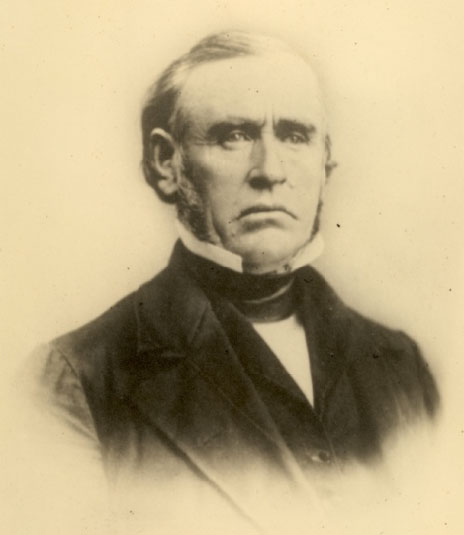
Samuel P. Hadley
This photo was provided to us by Fred Merriam from the Chelmsford Historical Society’s collection. It would be appropriate to obtain CHS permission to use this photo.
The next image is a map prepared in 1911 by Judge Samuel P. Hadley, son of the man pictured above, as part of an extensive paper written by him and published in a journal of the Old Residents’ Historical Society in Lowell. (Hadley, Honorable Samuel P., “Boyhood Reminiscences of Middlesex Village”; Contributions of the Lowell Historical Society, Lowell, MA; Vol. 1, April 1913, pp.184-5) The map shows the location of the toll house immediately to the west of and at the top of the three-lock staircase connecting the canal with the Merrimack River. In this map, only two locks are indicated. It may be that the lower gates for the bottom lock are immediately below the railroad, or it may be that the bottom lock was flooded out by the lake created behind the Pawtucket Dam and only the middle and upper locks functioned thereafter. (I’m inclined to believe that the latter is the case. This is a point that we, the MCA, should resolve.) Certainly the basin that once existed in the river, just beyond the lower lock, is gone. (I believe but cannot yet prove, that it was replaced by a berm-protected, artificial channel on the opposite side of the river.)
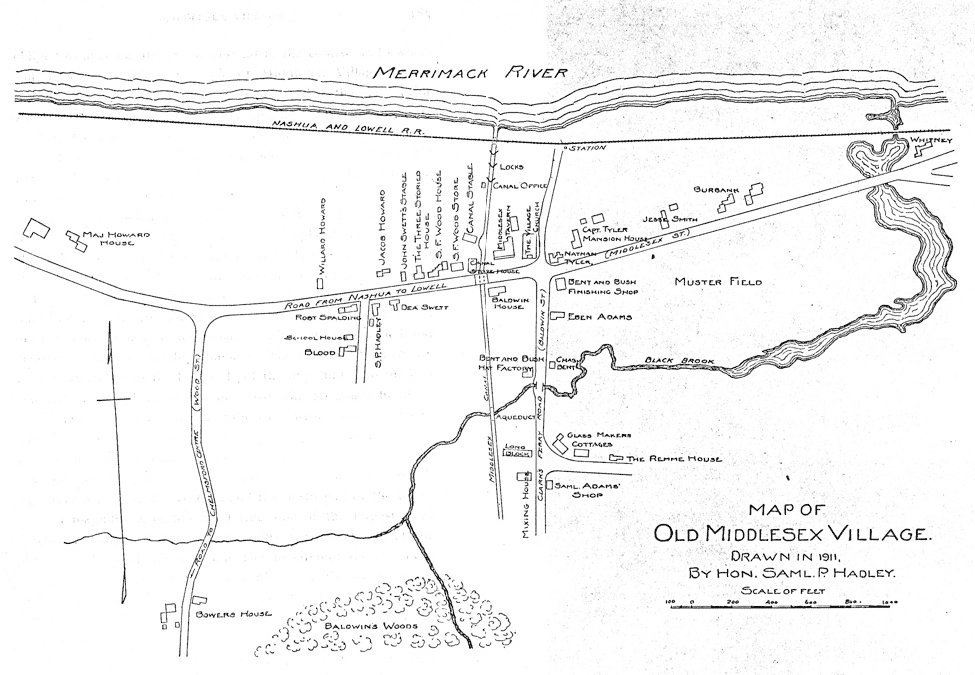
The building labeled Canal Storage House once was the Chelmsford Landing, i.e., Landing #8 of eight Landings originally constructed by the M’sex Canal Company. These were ‘stations’ where people could bring their goods to be shipped on the canal, or retrieve goods that had been shipped to them. I have copies of two drawings made of this Landing that I can send you if they would be useful. The implication of the label is that the building no longer served its original purpose, i.e., as a Landing.
The next four, and final, images are of the toll house, taken when it was still in its original location. (Note that there is some sort of discontinuity on the left side of the third photo.)
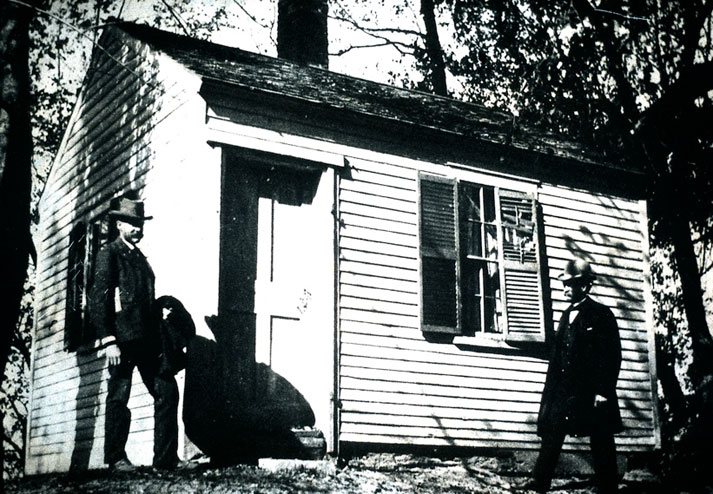
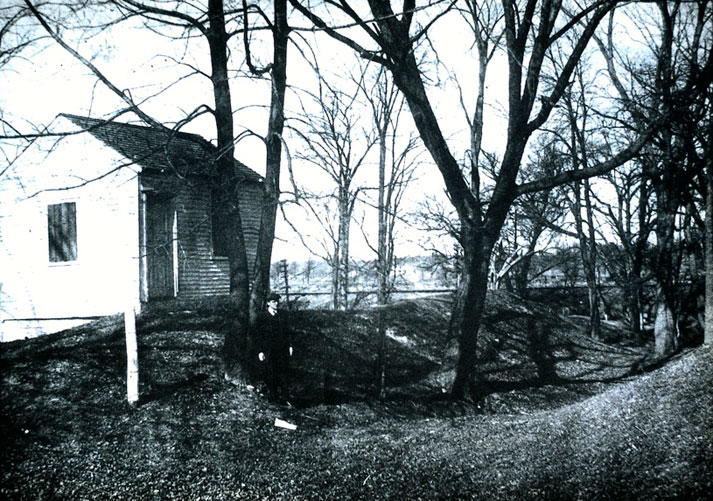
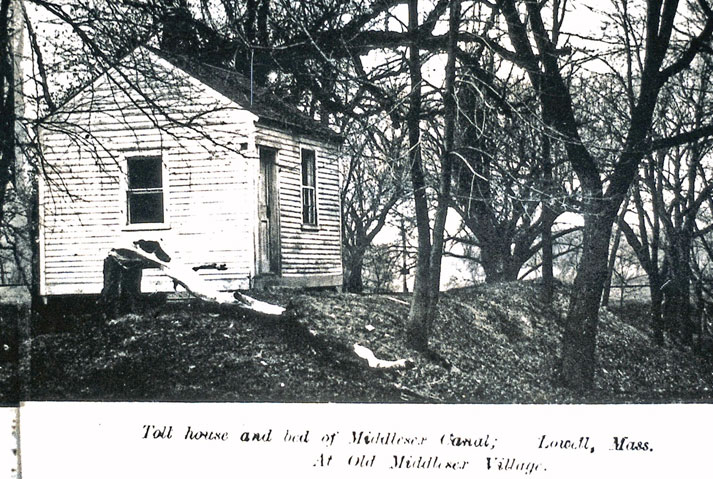
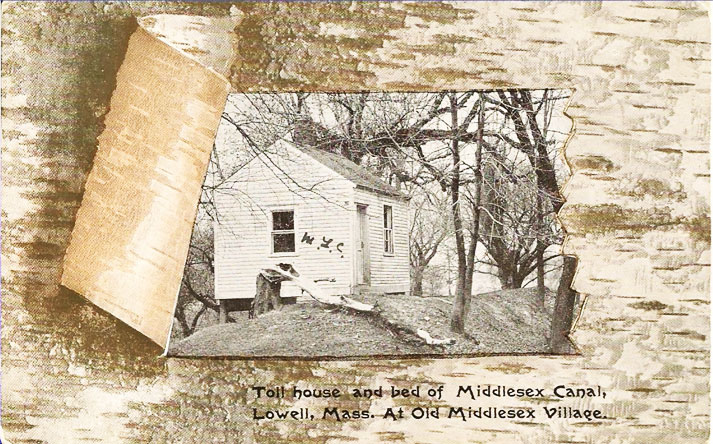
MISCELLANY
Nameplate - Excerpt from a watercolor painted by Jabez Ward Barton, ca. 1825, entitled “View from William Rogers House”. Shown, looking west, may be the packet boat George Washington being towed across the Concord River from the Floating Towpath at North Billerica.
Back Page - Excerpt from an August,1818, drawing (artist unknown) of the Steam Towboat Merrimack crossing the original (pre-1829) Medford Aqueduct, probably on its way to service on the Merrimack River.
Estate Planning - To those of you who are making your final arrangements, please remember the Middlesex Canal Association. Your help is vital to our future. Thank you for considering us.
Museum & Reardon Room Rental - The facility is available at very reasonable rates for private affairs, and for non-profit organizations’ meetings. The conference room holds up to 60 people and includes access to a kitchen and rest rooms. For details and additional information please contact the museum at 978-670-2740.
Web Site - As you may have noted in the nameplate, www.middlesexcanal.org is the URL for the Middlesex Canal Association’s web site. Our webmaster, Robert Winters, keeps the site up to date, thus events and sometimes articles and other information will sometimes appear there before we can get it to you through Towpath Topics. Please do check the site from time to time for new entries. Also, the site now contains a valuable repository of historical information, all of the back issues of TT, and an index to all of the articles contained therein, can now be found there at http://middlesexcanal.org/towpath.
Back Issues - Fifty years of back issues of Towpath Topics, together with an index to the content of all issues, are also available from our web site at middlesexcanal.org/towpath. These are an excellent resource for anyone who wishes to learn more about the canal and should be particularly useful for historic researchers.
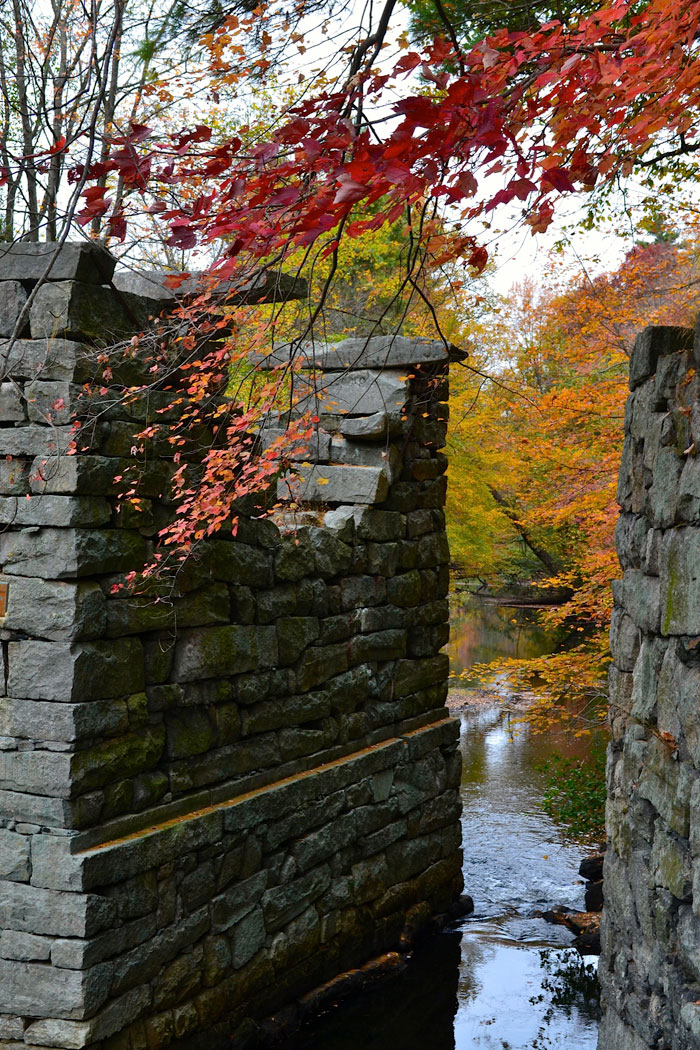
Shawsheen Aqueduct in October 2013
photo by Kathy Norton

Towpath Topics is edited and published by Bill Gerber and Robert Winters.
Corrections, contributions, and ideas for future issues are always welcome.